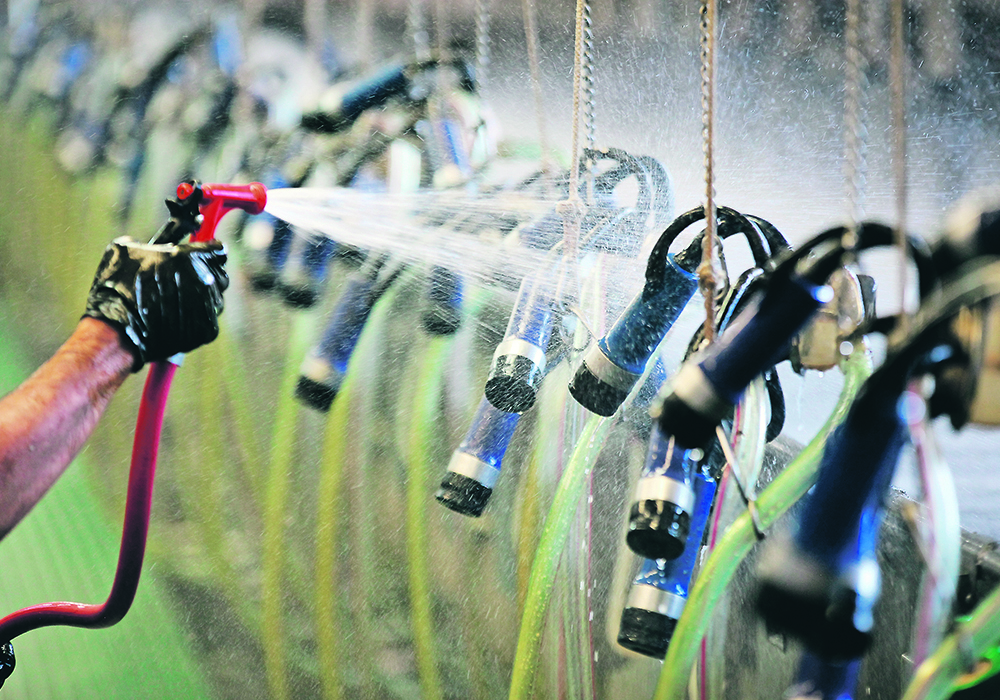Water use efficiency should be a priority and minor changes can achieve significant decreases, says AAFC researcher
Small changes can pay dividends in water use on dairy farms, financially and in preserving water quality and supply.
Determining where to make those changes takes careful monitoring and investigation.
That’s a message in research by Agriculture Canada researcher Andrew VanderZaag.
He has studied water use on dairy farms in Ontario, British Columbia and Quebec since 2016.
VanderZaag said during a recent dairy symposium in Ontario that achieving water efficiency differs from pursuing a decreased carbon footprint because the water supply is local. Areas of the country more prone to drought don’t face water supply or quality challenges because of limited demand and a sparse population.
Read Also

More work wanted on removing red tape
REGINA — Canadian farmers risk falling further behind competitors if two main federal agencies don’t become more efficient and responsive…
His research has focused on “direct” water use by dairy farms, but he acknowledged a significant impact from “indirect” use.
For example, for farms in jurisdictions where thermal power generation is common, the total water balance tipped significantly if indirect water use is considered.
Purchased feed is another potentially significant contributor to indirect water use on dairy farms. If feed comes from farms using irrigation, dairy producers concerned about their operation’s water balance could consider looking for another supplier.
Regarding direct water use, VanderZaag has seen several good examples of minor changes to achieve significant decreases. One eastern Ontario farm was using about six litres of water per day for each litre of milk produced and had recently increased the milking herd to about 400.
The farm hadn’t yet upgraded the holding tank receiving water for ultimate diversion to drinking purposes from the pre-bulk tank plate cooler. During the morning milking, the tank overflowed when the cows drank less, and water was lost to the liquid manure.
Increasing the capacity of the holding tank saved more than 10,000 litres of water per day, and the farm’s estimated annual water use fell from 33 million to 29 million litres.
Irrigated crops top the list for direct water use at 53 percent.
Water use attributed to greenhouse operations accounts for 13 percent, leaving livestock farms with approximately 30 percent of the province’s agriculture water use.
According to internationally recognized standards for measuring the water efficiency of food products, using water means consuming it and taking it out of the watershed — including in the milk — or decreasing its quality within the watershed.
One key point of livestock water use is much of it is consumed compared to other agricultural operations.
An average of 67 percent of water dairy cows use is for drinking; the rest is in the feed. One-quarter goes to the milk, but the majority goes into the manure — 44 percent in the feces and 14 percent in the urine. The rest consumed by the cows enters the atmosphere through respiration and transpiration.
Heat and humidity adversely affect dairy production, yet water consumption increases in those conditions. A farm striving to maximize its milk production per litre of water used can see a significant drop in that parameter if heat and humidity rise in the barn.
Managing the in-barn environment can, therefore, play a considerable role, VanderZaag said, adding it pays to track temperature-humidity index (THI) units in dairy housing and manage ventilation accordingly. His research shows mechanical systems generally perform better than natural systems for bringing cooler night air into the barn overnight.
Excess protein and salt in the ration can push up water consumption, so it’s important to ensure cattle get their optimum amounts.
Water use tends to be more significant in the summer, running at 23 percent more on average than in winter for herds housed indoors year-long. It rises to 33 percent more than winter for cattle housed outdoors during the pasturing season.
For water not consumed by the cows, almost all is used to clean the milking area and the milking system with minimal amounts for other general cleaning and, if present, misting mechanisms for cooling the cows.
VanderZaag said misters are a good idea, even if they use water, because their cooling effects decrease water consumption.
Untended leaks in the water system can be significant, so producers should check on everything, VanderZaag said.
It’s also common for different people cleaning the system to use different amounts of water. He advised determining the most water-efficient method and creating a standard operating procedure that all personnel should follow.
Even if environmental sustainability isn’t a top priority for a dairy farm, he suggested maximizing water use efficiency should be a priority. There are costs to using too much water, ranging from water system maintenance to water treatment products to liquid manure storage capacity issues and the machinery used to handle that manure.

















